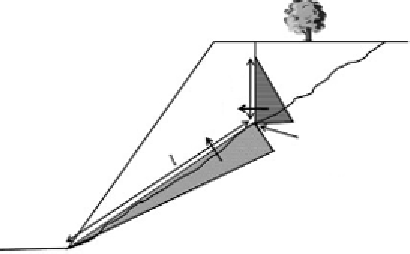Geology Reference
In-Depth Information
Figure 6.23
Typical model for
analysing in
uence
of water pressure
on stability of a
sliding rock slab.
z
w
V
U
Water pressure here,
P
=
z
w
×
9.8 kN/m2
Water force exerted on vertical joint,
V
=
0.5
×
z
w
×
P kN
Water uplift force on potential sliding surface
U
=
0.5
×
l
×
P kN
pressures at each location, all acting at the same time, because instru-
ments clearly showed pulses of water pressure travelling through the
slope, following a rain storm.
Even small intact rock bridges can provide suf
cient true cohe-
sion to stop seemingly hazardous slopes from failing (
Figure 5.19).
This can be a major dilemma because the rock bridges cannot be
seen or identi
ed by any realistic investigation method. Careful
geological study has failed to identify a useable link between per-
sistence and any other measurable joint characteristic (Rawnsley,
1990) and,
'
s
surface may be poor representations of characteristics inside the
unexposed mass, because of stress relief and weathering. Because of
this uncertainty, designs will typically require the risk of failure to
be minimised by incorporating toe buttresses, reinforcement with
anchorages of some kind, or some other protection, possibly using
an avalanche shelter.
From experience, wedge failures are relatively rare so that even
where these are identi
it must be remembered, traces exposed at the Earth
ed as a problem from stereographic analysis,
this might not develop in practice. Similarly, most slopes that
appear to have a toppling problem do not do so in reality, generally
because of impersistence. Care must be taken, therefore, to be
realistic in appraising the results of any geometrical analysis that
suggests there to be a problem. One factor that must be considered
is risk, which is the product of hazard (likelihood of a failure) and
consequence (likelihood of injury or damage). One other aspect is
that where major failures do occur, it is often found by later
inspection that the rock mass was in serious distress long before
failing and this might have been discovered by carefully targeted
investigation. Key factors to look for are open and in
lled joints
and distorted trees, though again the situation might be less risky
than it immediately appears
(Box 6-4)
. There is no easy answer to
this
it is a matter requiring observation, measurement, analysis,
experience and judgement, and consideration of consequence.
-

